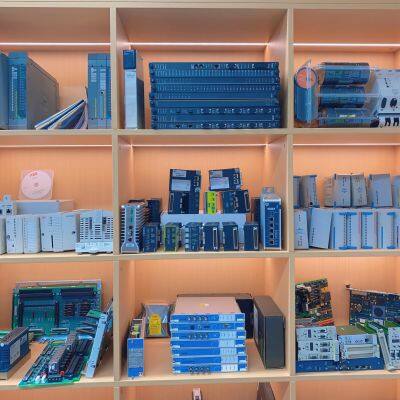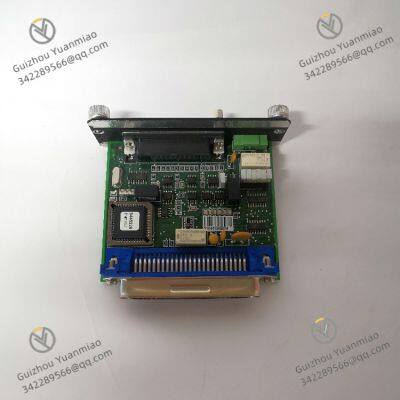Descripción del producto
I. Descripción general
Metso D200175 es un módulo de control de accionamiento de alta precisión, cuya posición central es proporcionar una solución de todo el enlace de "generación de se?al de accionamiento - control de bucle cerrado de velocidad - monitoreo de carga - protección contra fallas" para sistemas de accionamiento pesados, como conveyores de cinta de minas, accionamientos auxiliares de laminadores metalúrgicos y equipos de transporte en líneas de producción de materiales de construcción. Como componente clave de los sistemas de control de accionamiento de Metso (por ejemplo, Metso Outotec Drive System, Metso DNA Integrated Control Platform), su esencia radica en lograr una regulación precisa de la velocidad de motores asíncronos y síncronos a través de algoritmos de control de motores de alto rendimiento y circuitos de hardware altamente confiables. Al mismo tiempo, monitorea en tiempo real parámetros clave del sistema de accionamiento, como corriente, voltaje y temperatura, y responde rápidamente a condiciones de funcionamiento anormales, como sobrecarga, bloqueo y sobrecalentamiento. Es especialmente adecuado para entornos industriales hostiles con alta carga, alta vibración e interferencia electromagnética fuerte (por ejemplo, conveyores de cinta de minas subterráneas, unidades de accionamiento de trituradoras en líneas de producción de cemento).
Adoptando una arquitectura de hardware compacta sin ventilador, es compatible con varias se?ales de retroalimentación de velocidad de codificadores incrementales y codificadores absolutos, y admite múltiples métodos de salida de accionamiento, como PWM (Modulación de Ancho de Pulso) y se?ales analógicas, lo que permite el accionamiento directo de convertidores de frecuencia o accionamientos servo. Sus funciones dedicadas integradas, incluyendo protección contra sobrecarga, detección de bloqueo y monitoreo de la temperatura del motor, pueden prevenir efectivamente fallas mecánicas y da?os eléctricos en el sistema de accionamiento; cuando se utiliza con el software de gestión de accionamiento de Metso, puede realizar el seguimiento de parámetros de accionamiento y la evaluación del estado de salud, formando un ciclo cerrado completo de "control - monitoreo - diagnóstico". Ya sea el control de velocidad constante de conveyores de cinta, la regulación adaptativa a la carga de trituradoras o la sincronización precisa de velocidad de equipos auxiliares de laminadores, el D200175 puede mejorar la estabilidad y confiabilidad del sistema de accionamiento a través de un dise?o especializado, convirtiéndolo en un equipo central para que las industrias de procesos logren actualizaciones de automatización de accionamiento.

II. Parámetros técnicos
(I) Parámetros de entrada/salida de se?al
Configuración de canales de entrada
Entrada de retroalimentación de velocidad: 2 canales de entrada de codificador independientes, compatibles con codificadores incrementales (fases A/B, 5V/24V, frecuencia máxima 500kHz) y codificadores absolutos (interfaz RS485, que admite el protocolo Modbus). Puede recopilar en tiempo real la velocidad del motor (0-3000rpm) y se?ales de dirección, con una precisión de medición de velocidad de ±0.01%, lo que garantiza un error de control de velocidad de ≤0.1%.
Entrada de se?al de estado: 12 canales de entrada digital aislados (DI), que admiten se?ales de 24V CC, con un tiempo de respuesta de entrada de ≤1ms. Es adecuado para se?ales de interruptores de protección contra sobrecarga de motores, botones de parada de emergencia, interruptores de límite de sistemas de accionamiento y sensores de carga. La tensión de anti-interferencia es ≥250V CA (durante 1 minuto), lo que previene disparos falsos causados por interferencia electromagnética en sitios industriales.
Entrada de comando de control: 1 entrada de comando de control analógico (4-20mA CC, correspondiente a una velocidad de 0-3000rpm) o 1 entrada de comando de control digital (24V CC, para control de arranque/parada y marcha adelante/reversa), que admite la entrada de se?ales de conmutación de modo de control manual/automático.
Configuración de canales de salida
Salida de control de accionamiento: 2 canales de salida PWM (frecuencia de pulso 0-20kHz, ciclo de trabajo 0-100%) o 1 canal de salida analógico (4-20mA CC), que pueden accionar directamente convertidores de frecuencia o accionamientos servo. La precisión de salida es ±0.2% FS, con una capacidad de carga de ≤2A (para salida PWM) y ≤500Ω (para salida analógica), lo que garantiza una precisión de regulación de velocidad del motor de ≤0.1%.
Salida de alarma y estado: 6 canales de salida de relé (DO), cada uno con una corriente de carga nominal de 5A@250V CA / 10A@30V CC, que admiten contactos normalmente abiertos/normlamente cerrados configurables. Se utilizan para alarmas de fallas de sistemas de accionamiento (por ejemplo, sobrecarga, bloqueo, sobrecalentamiento) e indicación de estado (por ejemplo, funcionando/parado, giro adelante/reversa), con una vida mecánica de ≥10 millones de ciclos y una vida eléctrica de ≥100,000 ciclos (bajo carga nominal).
(II) Parámetros eléctricos y de rendimiento
Alimentación y consumo de energía
Voltaje de alimentación: 24V CC (con tolerancia de fluctuación de ±15%), compatible con módulos de alimentación CC industriales comúnmente utilizados (por ejemplo, fuentes de alimentación conmutadas de 24V/10A), eliminando la necesidad de equipos de alimentación dedicados.
Consumo de energía en modo de espera: ≤4W; Consumo de energía bajo carga máxima: ≤15W. El dise?o de bajo consumo es adecuado para escenarios de control de accionamiento de emergencia con respaldo de batería (por ejemplo, conveyores de cinta de emergencia en minas subterráneas).

Rendimiento de control
Precisión de control de velocidad: La precisión de control de velocidad del motor es ≤0.1%, con un rango de regulación de velocidad de 0-3000rpm, que admite ajustes finos de velocidad (paso de ajuste mínimo de 1rpm). Es adecuado para escenarios, como el control de velocidad constante de conveyores de cinta y la regulación adaptativa a la carga de trituradoras.
Velocidad de respuesta: El tiempo de respuesta del comando de control es ≤50ms, y el tiempo de corrección de desviación de velocidad es ≤300ms, lo que puede suprimir rápidamente las desviaciones de velocidad causadas por fluctuaciones de carga (por ejemplo, caída de velocidad ≤0.5% cuando el conveyor de cinta está cargado).
Algoritmos de control dedicados: Algoritmo de regulación de velocidad PID incorporado, algoritmo adaptativo a la carga y algoritmo de detección de bloqueo. Puede ajustar dinámicamente la salida de accionamiento según los cambios de carga (por ejemplo, aumentar automáticamente la potencia de accionamiento cuando aumenta la carga del conveyor de cinta), identificar el bloqueo del motor (por ejemplo, retroalimentación de velocidad ≤10rpm y corriente de accionamiento que supera el 200% del valor nominal) y desencadenar acciones de protección.
(III) Parámetros ambientales y de compatibilidad
Adaptabilidad ambiental
Temperatura de funcionamiento: -25℃~+70℃, humedad 5%~95% HR (sin condensación). Puede funcionar de manera estable en entornos, como minas subterráneas (alta temperatura y humedad), talleres metalúrgicos (alta polución y temperatura) y líneas de producción de materiales de construcción (alta polución) sin dispositivos de control de temperatura adicionales.
Nivel de protección: IP20 (el propio módulo); cuando se utiliza con la carcasa sellada dedicada de Metso, se puede actualizar a IP54, aislando efectivamente el polvo y la humedad y adaptándose a escenarios industriales polvorientos y húmedos.
Anti-interferencia y anti-vibración: Cumplimiento de las normas IEC 61000-4-2 (Descarga por aire ESD ±15kV) y IEC 61000-4-3 (Inmunidad a radiación 10V/m). Puede soportar vibraciones mecánicas de 10-500Hz (aceleración 2g), lo que garantiza se?ales estables en el entorno de vibración de equipos de accionamiento pesados.
Compatibilidad del sistema
Adaptabilidad a equipos de accionamiento: Compatible de forma nativa con convertidores de frecuencia y accionamientos servo de la serie Metso Outotec, y también admite equipos de accionamiento de terceros (por ejemplo, convertidor de frecuencia Siemens MM440, convertidor de frecuencia ABB ACS510). Puede adaptarse a los requisitos de control de convertidores de frecuencia de diferentes marcas a través de la configuración de parámetros.
Interfaz de comunicación: Interfaz de comunicación RS485 estándar (protocolo Modbus RTU), con módulo Ethernet opcional (protocolo Profinet). Puede conectarse a sistemas DCS/PLC, que admiten la emisión de comandos de control de accionamiento, la lectura de retroalimentación de velocidad y la carga de información de fallas para lograr monitoreo remoto y gestión centralizada.

III. Características funcionales
(I) Control de bucle cerrado de velocidad de alta precisión para escenarios de accionamiento pesado
Algoritmos de control de velocidad dedicados incorporados para resolver los problemas de insuficiente precisión y mala adaptabilidad a la carga del control de accionamiento tradicional:
Algoritmo de regulación de velocidad PID: Dirigido a las características de gran inercia y fluctuaciones frecuentes de carga de motores pesados, optimiza la lógica de autoajuste de parámetros PID. Puede ajustar dinámicamente los parámetros proporcional (P), integral (I) y derivativo (D) según las desviaciones de velocidad para evitar el sobrepico de velocidad (por ejemplo, sobrepico de velocidad<1%). It is suitable for scenarios such as constant speed control of belt conveyors (speed error ≤0.1%) and load-adaptive regulation of crushers.
Load-Adaptive Control: Real-time monitors the motor load current (collected through DI or AI channels). When the load increases (e.g., material accumulation on the belt conveyor), it automatically increases the drive output power to maintain stable speed (speed drop ≤0.5%); when the load exceeds 120% of the rated value, it triggers an overload warning to prevent motor damage due to overload.
Stall Detection and Protection: Real-time compares the drive command with the speed feedback. When the speed feedback ≤10rpm and the drive current exceeds 200% of the rated value (for 2 consecutive seconds), it determines that the motor is stalled, immediately stops the drive output, triggers a DO alarm (e.g., "E02: Motor Stall"), and cuts off the motor power supply to prevent motor burnout or drive mechanism damage.
For example, in the control of mine belt conveyors, the module controls the speed error of the belt conveyor within ±1rpm (rated speed 1000rpm) through the PID speed algorithm. Even if the load of the belt conveyor suddenly increases from 50% to 100%, the speed fluctuation is still ≤5rpm, effectively avoiding material accumulation or belt slipping.
(II) Multi-Dimensional Status Monitoring for Full-Status Management of Drive Systems
Supports comprehensive monitoring of the drive system's speed, load, electrical parameters, and mechanical status, forming a complete status profile:
Speed and Direction Monitoring: Collects real-time motor speed (0-3000rpm) and direction signals through 2 encoder input channels, displays the speed value and direction status (forward/reverse rotation) on the upper computer, and records the speed change trend (e.g., storing data once per second).
Load and Electrical Parameter Monitoring: Collects the motor overload protection signal through the DI channel, and collects the motor operating current (4-20mA feedback) through the extended AI channel. When the current exceeds the rated value (e.g., 2A), it triggers an overload warning.
Mechanical Status Monitoring: Collects signals from the drive system's limit switches (e.g., belt conveyor deviation switch, crusher spindle limit) and emergency stop buttons through the DI channel. When the limit switch is triggered, it immediately stops the drive output to prevent collision damage to the mechanical structure.
In the control of auxiliary drives for metallurgical rolling mills, the module can precisely control the speed of the rolling mill's auxiliary roller table (error ≤0.1%) by monitoring the motor speed and load current, while preventing motor overload caused by roller table jamming, reducing the failure rate of the drive system by 30%~40%.
(III) Flexible Interlocking Logic for Safe Operation of Drive Systems
Supports custom drive control interlocking logic to meet the safety requirements of process industries:
Emergency Stop Interlocking: Can be configured with interlocking logic such as "Emergency stop button triggered (DI1) → Stop drive output (PWM/AO) + Cut off motor power supply (DO1)" and "Belt deviation (DI2) → Decelerate to stop (DO2)", with a response time of ≤50ms. It is suitable for scenarios such as mine belt conveyors and metallurgical roller tables.
Bumpless Manual/Auto Switching: Supports bumpless switching between local manual adjustment (e.g., setting speed via a knob) and remote automatic control (e.g., DCS command). The speed fluctuation during switching is ≤0.5%, avoiding working condition disturbances (e.g., interruption of material conveying by the belt conveyor).
Fault Degraded Operation: When the module communication is interrupted, it automatically maintains the current speed output or executes a preset fault action (e.g., reducing to a safe speed of 500rpm) to prevent equipment damage or production interruption caused by drive system out of control.
In the drive control of crushers in building materials production lines, when the crusher spindle limit switch is triggered (DI3), the module immediately triggers the interlocking logic, stops the drive output within 100ms, and cuts off the crusher power supply to prevent mechanical damage caused by spindle overtravel.
(IV) Convenient Operation & Maintenance and Data Tracing for Reduced Management Costs
Status Visualization: The module panel is equipped with speed indicator lights (segmented display of 0-3000rpm), fault alarm lights (red), and operation status lights (green, distinguishing forward/reverse rotation), which can intuitively determine the current status of the drive system (e.g., the indicator light showing "800rpm" means the current speed is 800rpm, and a flashing red light indicates a stalling fault).
Data Storage and Tracing: Built-in 1-year historical data storage function, recording motor speed, load current, fault information, control commands, etc. It supports data export via RS485 for drive system health evaluation (e.g., statistics of motor operating time, analysis of overload frequency).
Online Parameter Configuration: Remotely configures PID parameters, interlocking logic, and alarm thresholds (e.g., overload current threshold, stall determination time) through Metso's dedicated software (e.g., Metso Drive Manager) without on-site module disassembly. The modification time for a single parameter is ≤1 minute, reducing operation and maintenance time and costs.

IV. Application Scenarios
(I) Mining Industry: Belt Conveyor Drive Control
In the drive system of underground belt conveyors in metal mines, the D200175 plays a core control role:
Signal Collection: Encoder Input 1 (PI1) collects the encoder signal (A/B phase, 500kHz) of the belt conveyor drive motor, providing real-time speed feedback (0-1000rpm); DI1-DI4 channels are connected to the belt deviation switch, pull-cord emergency stop button, motor overload protection switch, and level sensor signals; the extended AI1 channel collects the motor operating current (4-20mA corresponding to 0-5A).
Control Logic: Under normal working conditions, it receives the 4-20mA control command from the DCS (AI2, corresponding to a speed of 0-1000rpm), drives the frequency converter through PWM output, and controls the belt conveyor speed (e.g., 800rpm); when the level sensor detects material accumulation (DI4 triggered), it automatically reduces the speed to 500rpm to prevent material overflow.
Fault Protection: When the belt deviates (DI1 triggered) or the pull-cord emergency stop is activated (DI2 triggered), it immediately stops the PWM output (to shut down the drive frequency converter), and at the same time triggers DO1 to cut off the motor power supply and DO2 to activate the braking device; when the motor current exceeds 5A (AI1 out of range), it determines an overload, triggers DO3 for alarm, and uploads fault information to the mine dispatch center.
(II) Metallurgical Industry: Drive Control of Rolling Mill Auxiliary Roller Tables
In the drive system of auxiliary roller tables for hot-rolled steel plate production line rolling mills, the application value of the module is significant:
High-Precision Speed Control: Encoder Input 1 (PI1) collects the encoder signal (absolute encoder, RS485) of the roller table motor, providing speed feedback (0-500rpm); it receives the digital control command (DI5, forward/reverse rotation) and analog speed command (AI1, 4-20mA corresponding to 0-500rpm) from the rolling mill main control system, drives the servo drive through analog output (AO1), and controls the roller table speed (error ≤0.5rpm).
Load-Adaptive Regulation: Collects the roller table motor load current (4-20mA corresponding to 0-3A) through the AI2 channel. When the steel plate enters the roller table (load increases, current rises from 1A to 2.5A), it automatically increases the drive output to maintain stable speed (fluctuation ≤1rpm).
Interlocking Protection: When the roller table limit switch is triggered (DI6, steel plate overtravel), it immediately stops the drive output, and at the same time triggers DO1 to cut off the roller table power supply to prevent collision damage to the steel plate; when communication is interrupted, it automatically maintains the current speed (e.g., 300rpm) to ensure production continuity.
(III) Building Materials Industry: Drive Control of Crushers in Cement Production Lines
In the drive system of crushers (e.g., jaw crushers) in cement production lines, the module realizes the following functions:
Speed and Load Control: Encoder Input 1 (PI1) collects the encoder signal (incremental, 500kHz) of the crusher spindle motor, providing speed feedback (0-1500rpm); it drives the frequency converter through PWM output to control the spindle speed (e.g., 1000rpm); it collects the crusher over-torque sensor signal through the DI3 channel. When the torque exceeds 120% of the rated value, it automatically reduces the speed to 800rpm to prevent spindle overload.
Stall Protection: Real-time compares the drive command with the speed feedback. When the speed feedback ≤10rpm (for 2 consecutive seconds) and the drive current exceeds 200% of the rated value, it determines material stalling, immediately stops the drive output, triggers DO2 for alarm ("E02: Motor Stall"), and uploads fault information to the cement plant DCS.
Remote Monitoring: Sube la velocidad de la trituradora, la corriente de carga y la información de fallas al sistema MES de la planta a través del protocolo Profinet. El personal de despacho puede verificar remotamente el estado del sistema de accionamiento y modificar los parámetros de velocidad (por ejemplo, ajustar de 1000rpm a 1100rpm) para lograr la operación y el mantenimiento remotos.


Metso Valmet A413062 DMU Unit V.07
Metso Valmet A413230 ECU Unidad de conexión Ethernet
ABB PPD513A-23-111615 controlador de excitación magnética
Sistema Instrumentado de Seguridad (SIS) TRICONEX módulo de control 4351B
Bentley Nevada 3500/22M Módulo de interfaz de datos transitorios
Bently Nevada 3500/15-05-05-00 módulo de alimentación
Módulo de procesador Triconex 3009
ABB GFD563A102 3BHE046836R0102 Módulo de interfaz de convección de excitación
ABB PPD117A3011 3BHE030410R3011 Controlador de excitación
ABB PCD231B101 3BHE025541R0101 Controlador de Unidad de Excitación
ABB 5SHY3545L0010 3BHE009681R0101 Módulo de tiristores de alta tensión
ABB PCD230A 3BHE022291R0101 Módulo de controlador
ABB 5SHY3545L0009 3BHB013085R0001 Módulo IGBT
Bently Nevada 3500/25 módulo de fase clave mejorado
Bently Nevada 3500/32 Módulo de relé de 4 canales
ABB PCD232A 3BHE022293R0101 Módulo de control del excitador
Bently Nevada 3500 series de módulos del sistema de monitoreo
Bently Nevada 3500/33 módulo de relé
ABB PCD235A101 3BHE032025R0101 Módulo de control de excitación
ABB PCD235C101 3BHE057901R0101 Controlador de unidad de excitación
Bently Nevada 3500/34 Módulo de relé triple redundante
ABB PCD530A102 3BHE041343R0102 Controlador
ABB PPD113B01-10-150000 Módulo de controlador
ABB PPD512A10-150000 3BHE040375R1023 Controlador de excitación
 yezi
?Hola! Bienvenido/a a mi tienda. Avísame si tienes alguna pregunta.
yezi
?Hola! Bienvenido/a a mi tienda. Avísame si tienes alguna pregunta.






